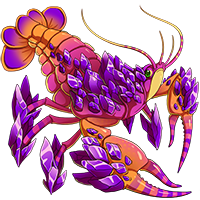

Kuiper
(#79439781)
Level 1 Nocturne
Click or tap to view this dragon in Predict Morphology.
Energy: 39/50

Expand the dragon details section.
Collapse the dragon details section.
Personal Style
Apparel
Skin
Scene
Measurements
Length
5.92 m
Wingspan
5.87 m
Weight
580.52 kg
Genetics
Blackberry
Starmap
Starmap
Mulberry
Bee
Bee
Mulberry
Opal
Opal
Hatchday
Breed
Eye Type
Level 1 Nocturne
EXP: 0 / 245


STR
7
AGI
6
DEF
7
QCK
6
INT
6
VIT
6
MND
7
Biography

Kuiper Belt – a doughnut-shaped region of icy bodies beyond the orbit of Neptune. The Kuiper Belt is truly a frontier in space – it's a place we're still just beginning to explore and our understanding is still evolving.
Similar to the asteroid belt, the Kuiper Belt is a region of leftovers from the solar system's early history. Like the asteroid belt, it has also been shaped by a giant planet, although it's more of a thick disk (like a doughnut) than a thin belt.
Astronomers think the icy objects of the Kuiper Belt are remnants left over from the formation of the solar system. Similar to the relationship between the main asteroid belt and Jupiter, it's a region of objects that might have come together to form a planet had Neptune not been there. Instead, Neptune's gravity stirred up this region of space so much that the small, icy objects there weren't able to coalesce into a large planet.
There may be millions of these icy objects, collectively referred to as Kuiper Belt objects (KBOs) or trans-Neptunian objects (TNOs), in this distant region of our solar system. Hundreds of thousands of icy bodies may be larger than 100 km (62 miles) and an estimated trillion or more comets within the Kuiper Belt.
Some dwarf planets within the Kuiper Belt have thin atmospheres that collapse when their orbit carries them farthest from the Sun; several dwarf planets within the Kuiper Belt have moons.
The first mission to explore the Kuiper Belt is New Horizons. It flew past Pluto in 2015 and is on its way to explore another Kuiper Belt world. It is not clear if worlds in this distant, cold region are capable of supporting life as we know it. Astronomers are searching for a possible planet that might explain the strange orbits of several Kuiper Belt Objects. The nickname: Planet 9.
Astronomers think the icy objects of the Kuiper Belt are remnants left over from the formation of the solar system. Similar to the relationship between the main asteroid belt and Jupiter, it's a region of objects that might have come together to form a planet had Neptune not been there. Instead, Neptune's gravity stirred up this region of space so much that the small, icy objects there weren't able to coalesce into a large planet.
There may be millions of these icy objects, collectively referred to as Kuiper Belt objects (KBOs) or trans-Neptunian objects (TNOs), in this distant region of our solar system. Hundreds of thousands of icy bodies may be larger than 100 km (62 miles) and an estimated trillion or more comets within the Kuiper Belt.
Some dwarf planets within the Kuiper Belt have thin atmospheres that collapse when their orbit carries them farthest from the Sun; several dwarf planets within the Kuiper Belt have moons.
The first mission to explore the Kuiper Belt is New Horizons. It flew past Pluto in 2015 and is on its way to explore another Kuiper Belt world. It is not clear if worlds in this distant, cold region are capable of supporting life as we know it. Astronomers are searching for a possible planet that might explain the strange orbits of several Kuiper Belt Objects. The nickname: Planet 9.
Click or tap a food type to individually feed this dragon only. The other dragons in your lair will not have their energy replenished.
Feed this dragon Insects.
Feed this dragon Meat.
This dragon doesn't eat Seafood.
This dragon doesn't eat Plants.
Exalting Kuiper to the service of the Arcanist will remove them from your lair forever. They will leave behind a small sum of riches that they have accumulated. This action is irreversible.
Do you wish to continue?
- Names must be longer than 2 characters.
- Names must be no longer than 16 characters.
- Names can only contain letters.
- Names must be no longer than 16 characters.
- Names can only contain letters.










